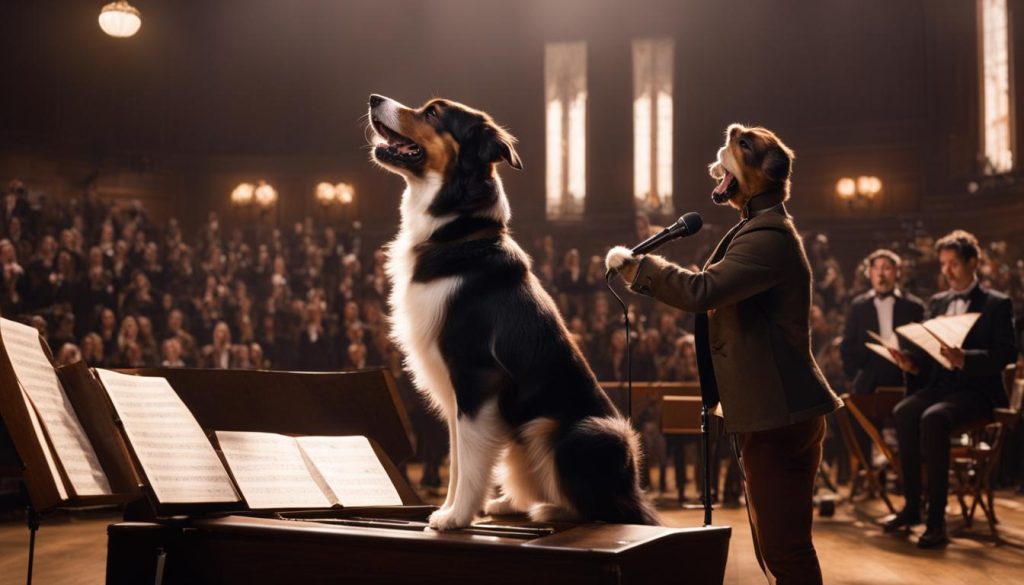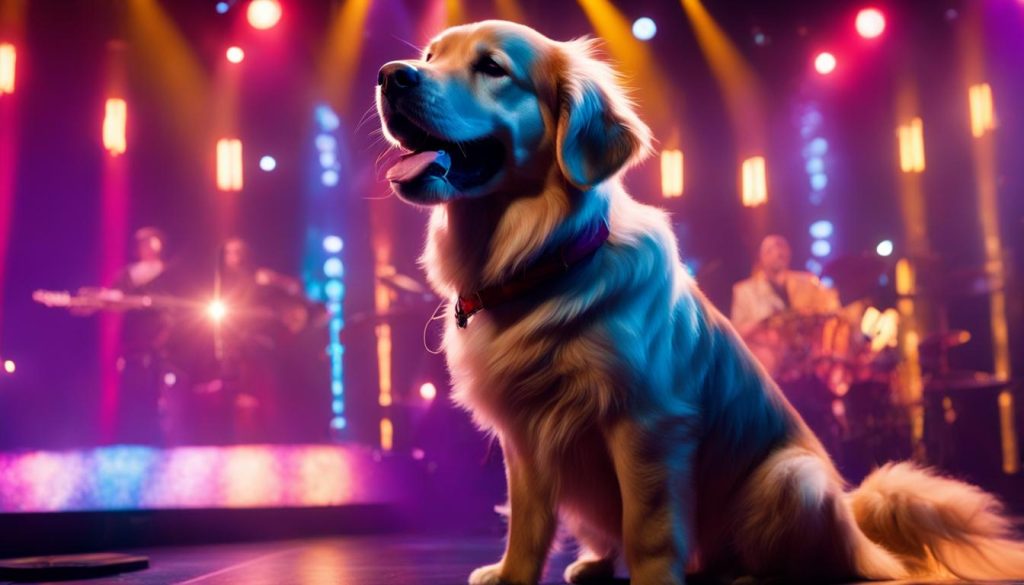Teaching a dog to sing or howl on command can be a fun and rewarding trick to teach your furry friend. While some dogs are naturally more vocal, even quiet dogs can learn this behavior through positive reinforcement training. In this article, I will go over a step-by-step process to teach your dog to sing, including capturing the behavior, shaping the behavior, and selecting a cue.
Key Takeaways:
- Teaching your dog to sing is a fun and rewarding trick that can be achieved through positive reinforcement training.
- Capturing the behavior involves identifying when your dog makes a sound similar to the desired end goal and rewarding them.
- Shaping the behavior entails rewarding specific variations of the singing behavior to refine it.
- Selecting and installing a cue involves creating a consistent command and rewarding your dog only when cued to sing.
- Alternate methods such as acting silly or playing a musical instrument can be used if your dog doesn’t naturally have a howl.
General Trick Training Tips
Before diving into teaching your dog to sing, understand some general trick training tips. These tips will help you create a positive and effective training environment for your furry friend:
- Keep your dog’s attention span in mind during training sessions. Dogs have varying levels of focus, so keep training sessions short and engaging to prevent them from losing interest.
- Break the training process into simple steps and gradually progress towards the desired behavior. This allows your dog to learn and master each step before moving on to the next.
- Always end on a win. Ending each training session on a positive note, with your dog successfully performing a trick or behavior, helps maintain their motivation and enthusiasm for future sessions.
- Most importantly, keep it fun! Training should be a enjoyable experience for both you and your dog. Incorporate playfulness, treats, and praise to make the training sessions enjoyable and rewarding.
By following these general trick training tips, you’ll be setting the foundation for successful training sessions with your dog. Try to be patient, consistent, and always reinforce positive behaviors. Now, let’s dive into the specific steps to teach your dog to sing!
General Trick Training Tips:
| Tip | Description |
|---|---|
| Attention Span | Keep your dog’s attention span in mind during training sessions. Keep them short and engaging. |
| Simple Steps | Break the training process into simple steps and gradually progress towards the desired behavior. |
| Ending on a Win | Always end each training session on a positive note, with your dog successfully performing a trick or behavior. |
| Keeping it Fun | Incorporate playfulness, treats, and praise to make the training sessions enjoyable and rewarding. |
The key to successful dog training is to create a positive and enjoyable experience for both you and your furry companion. By keeping your dog’s attention span in mind, breaking down the training process into simple steps, ending on a win, and making it fun, you’ll be well on your way to teaching your dog to sing.
Step 1: Capture the Behavior
The first step in teaching your dog to sing is to capture the behavior. If your dog already occasionally howls, try to identify when they make a sound similar to your desired end goal. For example, it could be when they want to go outside or when they hear certain music. When your dog makes the desired sound, reward them with training treats and establish a clear end goal sound for them to aim for.
Capturing the Behavior
One way to capture the behavior is by using a clicker. When your dog makes the desired sound, immediately click the clicker and give them a treat. This helps to reinforce the behavior and create a positive association with the sound they made. You can also use verbal praise and petting as rewards.
I recommend that you be patient during this step as it may take some time for your dog to consistently make the desired sound. Celebrate small victories and reward even the tiniest howl or vocalization that resembles your end goal sound. With practice and repetition, your dog will begin to understand what you are asking of them.
| Tip: | Use high-value training treats that your dog loves. This will motivate them to continue making the desired sound. Experiment with different treats to find out which ones your dog responds to the most. |
|---|---|
| Key Point: | By capturing the behavior and rewarding your dog for making the desired sound, you are laying the foundation for teaching them to sing on command. |
Establishing the End Goal Sound
Once you have successfully captured the behavior of your dog howling, it’s time to establish an end goal sound. This is the specific sound you want your dog to make when you give them the cue to sing. It could be a specific pitch, a certain duration, or a combination of different elements.
When selecting the end goal sound, consider your dog’s natural vocal range and what is comfortable for them. You want to choose a sound that is achievable for your dog and doesn’t cause any strain or discomfort. It’s also important to keep in mind that each dog’s singing abilities may vary, so be flexible and adapt the end goal sound to suit your individual dog.

To put it simply, teaching your dog to sing is a journey that requires patience, consistency, and positive reinforcement. Celebrate every small step of progress and have fun throughout the training process. With time and dedication, your dog will impress everyone with their singing talents!
Step 2: Shape the Behavior
After capturing your dog’s singing behavior, the next step is to shape it into the desired form. This involves rewarding specific variations of the behavior to gradually shape it towards your goal. For example, if your end goal is a longer or shorter howl, reward your dog when they produce the desired duration. Similarly, if you want your dog to sing in a high-pitched or low-pitched tone, reward them when they achieve the specific pitch you’re aiming for.
By shaping the behavior through rewards and positive reinforcement, you are guiding your dog towards the desired end result. Try to be patient and consistent during this process, as it may take time for your dog to fully understand and perform the behavior as desired. Continue to reinforce and reward the variations of singing that align with your specific goals.
Using a table, you can track your dog’s progress in shaping the behavior. Here’s an example of how it could look:

“By rewarding the desired howls, you can shape your dog’s singing behavior into the desired end product.”
Step 3: Select and Install the Cue
The final step in teaching your dog to sing is to select and install a cue. This step is crucial for establishing clear communication between you and your dog. By creating a consistent command and using it right before your dog howls, you can train them to associate the cue with the behavior of singing.
When selecting a cue, keep it simple and easy to remember. For example, you can use the word “Sing” or “Sing with me, Fido.” Use the cue every time you want your dog to sing, consistently saying it before they howl. This repetition helps your dog understand that the cue is a signal for them to perform the behavior.
I recommend that you remember that in this step, you should only reward your dog for singing when they are cued to do so. This helps prevent them from howling excessively or at inappropriate times. Gradually reduce the rewards for spontaneous singing and reinforce the behavior only when cued.
To reinforce the cue, continue to reward your dog with treats or praise when they respond to the command and sing on cue. With consistent practice and reinforcement, your dog will soon understand the cue and be able to sing on command.

Example Table: Reward System for Selecting and Installing the Cue
| Cue | Reward |
|---|---|
| “Sing” | Treats |
| “Sing with me, Fido” | Praise |
Alternate Method of Teaching Dogs to Sing
If your dog doesn’t naturally have a howl or a unique bark that resembles singing, you can try an alternate method to teach them to sing. This method involves getting a little silly and creative to encourage vocalization in a different way. Here are a few ideas to consider:
- Acting Silly: Make funny sounds and silly faces to catch your dog’s attention and encourage them to make noise. Sometimes, the more outrageous you act, the more likely your dog is to join in on the fun.
- Funny Faces: Make exaggerated facial expressions to elicit a response from your dog. Dogs are incredibly perceptive to human facial expressions, and your dog may mimic your expressions with their own unique vocalizations.
- Playing Musical Instruments: If you play a musical instrument, try playing it in your dog’s presence. The sounds and melodies can pique their curiosity and inspire them to vocalize or howl along with the music.
To put it simply, the key with this alternate method is to create a new sound or behavior that your dog can associate with the word “sing.” By acting silly, making funny faces, or playing a musical instrument, you can encourage your dog to vocalize in a different way and have some fun in the process.

| Pros | Cons |
|---|---|
| Fun and engaging for both you and your dog | May not work for all dogs |
| Allows you to bond with your dog through playfulness | Requires creativity and patience |
| Can be a great solution for dogs who are not naturally vocal | Results may vary and require consistent practice |
Try to always be patient and positive when teaching your dog to sing. I recommend that you create a safe and encouraging environment for your furry friend to explore their vocal abilities. With a little creativity and lots of love, you can help your dog discover their inner singing sensation!
Tips for Teaching Your Dog to Sing
Teaching your dog to sing can be an enjoyable and rewarding experience. Here are some tips to help you along the way:
- Ignore Barking: If your dog tends to bark instead of howl, ignore the barking and only reward them when they make even the tiniest howl. This will help them understand that howling is the desired behavior.
- Reward Small Progress: Even if your dog’s howls are not perfect at first, make sure to reward and encourage any attempts at singing. By rewarding even the smallest progress, you can build on their existing natural behavior and motivate them to continue.
- Build on Natural Behavior: If your dog already has a natural tendency to howl when excited or hearing certain sounds, use this behavior as a foundation for teaching them to sing. Associate their existing howling with the cue for singing and gradually shape it into the desired end goal sound.
To put it simply, patience and consistency are key when teaching your dog to sing. Each dog learns at their own pace, so tailor the training methods to suit their individual needs. Keep training sessions fun and positive, and soon your furry friend will be serenading you with their melodious voice!

Success Story: Building on Natural Behavior
“My dog, Bella, loves to howl whenever she hears sirens passing by. I decided to build on this natural behavior and teach her to sing. By using the cue ‘Sing’ whenever a siren went by, I was able to associate her howling with the command. With consistent practice and rewards, Bella now sings on command, much to everyone’s delight!” – Emily, proud dog owner
| Tips for Teaching Your Dog to Sing | |
|---|---|
| 1. | Ignore barking and reward even the tiniest howl. |
| 2. | Reward small progress to keep your dog motivated. |
| 3. | Build on your dog’s existing natural behavior, such as howling when excited or in response to certain sounds. |
Video Demonstrations
To further illustrate the process of teaching your dog to sing, here are video demonstrations of dogs singing on command. These videos showcase the steps and techniques discussed in this article and can serve as a visual guide for understanding the process.

Watching these videos can provide you with a clear demonstration of how to capture the singing behavior, shape it, and select the right cue for your dog. These video demonstrations feature dogs of different breeds and temperaments, showing that singing can be taught to any dog with patience and positive reinforcement.
By observing the training techniques used in the videos, you can gain additional insights and ideas on how to adapt the training process to suit your dog’s individual needs. To put it simply, every dog is unique, and it may take some trial and error to find the right approach. The videos can inspire you and give you the confidence to embark on this fun and rewarding journey with your furry friend.
So, sit back, relax, and enjoy these fascinating video demonstrations of dogs singing on command!
Troubleshooting Common Challenges
Teaching your dog to sing can come with its fair share of challenges. Some dogs may be naturally quiet, making it difficult to get them to vocalize on command. In such cases, you may need to employ different techniques to encourage singing behavior. Additionally, some dogs may exhibit inconsistent behavior, where they may howl in response to some cues but not others. This requires patience and persistence in the training process.
One common challenge is working with quiet dogs. These are dogs that naturally have a less vocal nature and may not readily howl or sing. To overcome this, refine the cue and specific rewards to encourage singing behavior. Experiment with different sounds, such as music or certain high-pitched noises, to see if your dog responds more enthusiastically to those stimuli. You can also try using a different cue word that resonates better with your dog.
Inconsistent behavior can also pose a challenge. Some dogs may howl in response to certain cues during training but may not consistently replicate this behavior in real-life situations. In these cases, practice the singing behavior in a variety of settings and contexts to help your dog generalize the cue and behavior. Be patient and provide consistent reinforcement when your dog does sing on command, gradually fading out the rewards as your dog becomes more reliable.
| Challenge | Troubleshooting Tips |
|---|---|
| Quiet dogs | Refine the cue and rewards to encourage singing behavior. Experiment with different sounds and cues that resonate better with your dog’s natural tendencies. |
| Inconsistent behavior | Practice singing behavior in various settings to help your dog generalize the cue. Be patient and provide consistent reinforcement to encourage consistent singing on command. |
To put it simply, every dog is unique, and some may require more time and patience than others to learn how to sing. Celebrate small victories and continue to reinforce the behavior through regular training sessions. With perseverance and a positive approach, you can overcome these common challenges and teach your dog to sing like a pro!
Practice Makes Perfect
As with any skill, practice is essential for teaching your dog to sing. Consistency and regular training sessions will help reinforce the singing behavior and improve your dog’s abilities. Set aside dedicated time each day to work on the singing command with your furry friend. Try to keep the training sessions short and fun, as dogs have shorter attention spans. Aim for multiple short sessions throughout the day rather than one long session.
During each training session, be sure to use positive reinforcement and rewards to motivate your dog. Praise and reward them with treats or their favorite toy when they successfully perform the singing behavior. Consistency in your training techniques and rewards will help your dog understand what is expected of them and encourage them to continue singing on cue.
every dog learns at their own pace, so be patient and keep practicing. Some dogs may pick up the singing command quickly, while others may take longer to master it. Stay consistent, stay positive, and celebrate even the smallest progress your dog makes. With time and practice, your dog will become a singing sensation!

Final Thoughts
In conclusion, teaching your dog to sing can be a rewarding and enjoyable experience for both you and your furry friend. By following the step-by-step process outlined in this article, you can successfully train your dog to vocalize on command.
Try to start by capturing the behavior, rewarding your dog for their desired howls, and shaping the behavior to achieve your desired end goal. Selecting and installing a cue will help establish clear communication with your dog, ensuring they only sing when cued to do so.
For those dogs that may not naturally have a howl, alternate methods such as acting silly, making funny faces, or playing a musical instrument can be effective in encouraging vocalization. Additionally, be patient, use positive reinforcement, and keep training sessions fun and engaging for both you and your dog.
Through the process of teaching your dog to sing, you will not only bond with your canine companion but also showcase their unique talents. So, get ready to enjoy the music and laughter that your singing dog will bring into your life!
FAQ
Can any dog learn to sing?
Yes, even quiet dogs can learn to sing with proper positive reinforcement training.
How do I capture the behavior of my dog howling?
Observe when your dog makes a sound similar to your desired end goal, such as when they want to go outside or hear certain music, and reward them when they make that sound.
How do I shape my dog’s singing behavior?
Reward specific variations of the behavior such as longer or shorter howls, high-pitched or low-pitched howls, depending on your desired goal.
What cue should I use to teach my dog to sing?
Choose a consistent command, like “Sing” or “Sing with me, Fido,” and use it right before your dog howls. Gradually, only reward your dog for singing when they are cued to do so.
What if my dog doesn’t naturally have a howl or unique bark?
You can try acting silly, making funny faces, or playing a musical instrument to elicit a vocalization from your dog. Associate this vocalization with the word “sing.”
How do I teach my dog to sing if they tend to bark instead of howl?
Ignore the barking and reward even the tiniest howl. You can also build on any existing natural behavior, such as howling when excited, and associate it with the cue for singing.
Are there any video demonstrations of dogs singing on command?
Yes, you can find video demonstrations that showcase the steps and techniques discussed in this article to guide you through the process.
What challenges might I face when teaching my dog to sing?
Some dogs may be naturally quiet, making it more difficult to get them to vocalize. Inconsistent behavior may also require patience and persistence in the training process.
How often should I practice singing training with my dog?
Consistency and regular training sessions are key to reinforce the singing behavior. Practice and repetition will help your dog improve their singing abilities.
Is teaching my dog to sing a rewarding experience?
Yes, teaching your dog to sing can be a fun and rewarding way to bond with your furry friend and showcase their unique talents.






